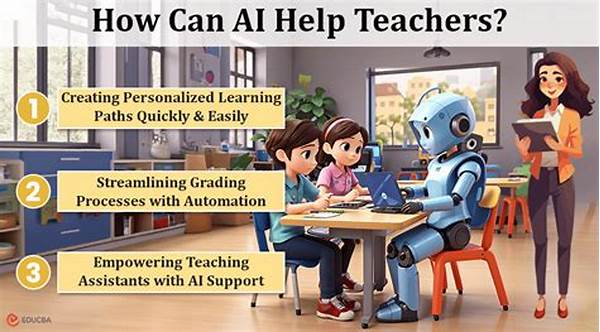- How AI Supports Teachers and Learners Equally
- The Balanced Support of AI for Educators and Learners
- The Purpose of AI in Education
- Elevating the Educational Experience
- Personalized Learning Paths for Students
- Goals for Implementing AI in Education
- Understanding the Impact of AI in Education
- How AI Enhances the Educational Environment
How AI Supports Teachers and Learners Equally
In a world that constantly evolves, the role of Artificial Intelligence (AI) in education has become a focal point of discussion, innovation, and transformation. Education is at the heart of societal growth, and ensuring that teachers and learners are equipped with the best resources is crucial. AI offers revolutionary solutions that cater to the needs of both educators and students, creating an environment where learning becomes adaptive, personalized, and efficient. Welcome to the future of education, where AI isn’t just a tool—it’s a partner in the learning journey.
Read More : How Ai Tutors Are Changing The Way Students Learn
AI’s integration into the educational landscape often invokes images of robots teaching classrooms or complex algorithms dictating lesson plans. In reality, the incorporation of AI in education is much more nuanced and human-centered. It’s about empowering teachers, giving them the tools to better understand their students and tailor their teaching strategies. Similarly, it provides students with a learning experience that is not one-size-fits-all but instead is uniquely crafted to meet individual learning styles and paces.
Let’s consider a classroom where AI is seamlessly integrated. Imagine a teacher sitting at their desk, sipping coffee while browsing an AI-powered dashboard. This dashboard provides insights into each student’s progress, highlighting areas of strength and opportunities for improvement. The teacher can develop strategies tailored for individuals, ensuring no student is left behind.
For students, AI transforms the typical classroom into an interactive experience. Picture students engaging with AI tutors that adapt to their learning speeds and challenges, offering hints and additional resources just when they’re needed. Whether it’s learning the complexities of algebra or the nuances of a new language, AI makes each student’s learning path unique and effective.
The Balanced Support of AI for Educators and Learners
AI in education serves as an equalizer. It supports teachers by alleviating mundane tasks such as grading and lesson planning, allowing them to focus on what they do best—teaching. Meanwhile, AI provides learners with an adaptive educational experience that adjusts to their needs in real-time.
—
The Purpose of AI in Education
In the bustling ecosystem of education, AI’s primary purpose is to enhance the learning and teaching experience equally for all participants.
While traditional education has its merits, it often misses the opportunity to cater to individual needs. AI fills this gap by offering personalized learning analytics that enable educators to understand each student’s learning trajectory. AI tools provide teachers with data-driven insights, enabling them to tailor their approaches to individual needs and significantly boost educational outcomes.
Elevating the Educational Experience
AI’s role in elevating the educational experience is transformative. Educators are given access to a wealth of information that previously required cumbersome manual tracking. AI-enabled solutions synthesize and present this data in intuitive formats, assisting teachers in pinpointing areas where students struggle or excel.
Personalized Learning Paths for Students
For students, AI unlocks a new way of experiencing education. It offers a dynamic response to their learning habits. AI systems can provide on-demand tutoring, offer practice exercises that target students’ weaknesses, and even focus on their interests to keep learning engaging and meaningful.
Ultimately, AI is designed to bridge the gap that often exists in education systems: ensuring that both teacher and learner receive optimal support to reach their full potential. AI doesn’t replace the human touch in education; instead, it amplifies it through smart, data-informed decision-making processes.
—
Goals for Implementing AI in Education
Understanding the Impact of AI in Education
As AI continues to evolve, it is crucial to understand its impact on education from various aspects. This includes how AI supports differentiated instruction, the potential for new teaching methodologies, and how AI breakthroughs can continue to redefine educational norms. The potential of AI in education is vast, encompassing both opportunities and challenges. It invites educators and learners alike to participate actively in this transformative journey.
How AI Enhances the Educational Environment
AI’s contributions to education can be quantified in several ways, ranging from enhanced engagement to improved learning outcomes. By facilitating access to personalized learning and providing teachers with robust data tools, AI creates a more inclusive and effective education system. The focus remains on using AI to support both teachers and learners equally, ensuring that each receives the necessary resources, insights, and upgrades to thrive in a modern educational landscape.
In conclusion, AI’s role in education is profound and multi-faceted. It provides a level playing field for teachers and learners, offering tools that are as valuable to a novice educator as they are to a seasoned professional. By bridging the gap between education’s potential and its practice, AI supports a future where learning is a shared journey—a partnership between technology, teachers, and students aimed at unlocking the full spectrum of human capability.


